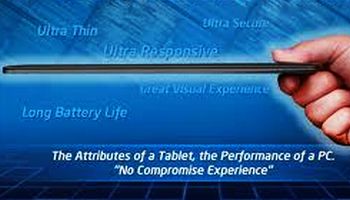Finally some good news for Intel’s ultrabook concept after it was estimated it will grab a sizeable portion of the laptop market.
IHS iSuppli analysts said that ultrabooks will rapidly gain popularity over the next several years, and will boost the entire supply chain.
Laptop Fightback
Ultrabooks will account for more than 40 percent of all notebooks by 2015, and will reinvigorate a listless PC market that has been hurt in part by the rise in popularity of tablets, in particular Apple’s popular iPad, according to IHS iSuppli.
 In a report 7 November, IHS iSuppli analysts said that within four years, 43 percent of all notebook shipments will be ultrabooks, an ultra-light and thin form-factor championed by giant chip maker Intel. The popularity of ultrabooks – the first of which are being released this quarter – will rise rapidly, the analysts predicted, becoming 28 percent of all notebook shipments by 2013 and 38 percent by 2014.
In a report 7 November, IHS iSuppli analysts said that within four years, 43 percent of all notebook shipments will be ultrabooks, an ultra-light and thin form-factor championed by giant chip maker Intel. The popularity of ultrabooks – the first of which are being released this quarter – will rise rapidly, the analysts predicted, becoming 28 percent of all notebook shipments by 2013 and 38 percent by 2014.
That popularity will be driven by the capabilities Intel and its OEM partners will put into the systems, and by the lineup of features that including not only traditional notebook offerings but also features found in tablets, including instant-on capabilities, solid-state drive (SSD) storage, always-connected wireless technology and longer battery life.
Eventually ultrabooks will include touch capabilities and new form-factors, including convertible capabilities, according to IHS iSuppli.
“To compete with media tablets, notebook PCs must become sexier and more appealing to consumers,” Matthew Wilkins, principal analyst for compute platforms at HIS iSuppli, said in a statement. “With media tablets having already reversed the expansion of the previously fast-growing netbook platform, PC makers now are keenly aware that the notebook must evolve to maintain market growth and relevance. Enter the ultrabook, which borrows some of the form-factor and user-interface advantages of the media tablet to enhance the allure of the venerable notebook.”
Intel executives first introduced the ultrabook strategy at the Computex 2011 show in May, and has been aggressively promoting the initiative since, particularly at the Intel Developer Forum in September. According to the chip maker, the systems must come in at 0.8 inches or less in thickness, and must be priced at less than $1,000 (£622).
Pricing Issue
The pricing has been a key concern in the industry since ultrabooks were first discussed, with some analysts unsure whether hitting the under-$1,000 price point could be hit. The pricing for the lower-end ultrabooks rolled out this quarter by Acer and Asus are coming in at less than $1,000, though other models cost more than $1,300.
Intel executives have said they understand that for their supply chain partners, developing products that enable such a price point will be difficult initially, and have created a $300 million fund to help with the effort. Intel also has introduced reference designs for OEM use.
The ultrabook push is seen as benefitting Intel in several ways, including as another avenue into the popular mobile device space – in particular smartphones and tablets – as well as a way to boost the PC market that it dominates and to give OEMs an answer to Apple’s MacBook Pro laptop.
Intel executives initially expected ultrabooks – which at first will be aimed at consumers, and later businesses – to account for 40 percent of the notebook market at the end of 2012. IHS iSuppli analysts say it will take at least another four years to hit that figure. The first systems will be based on Intel’s current “Sandy Bridge” 2nd Generation Core processors, but officials have said they expect more OEMs to jump into the mix in the next round of systems, which will run on Intel’s “Ivy Bridge” processors. Other ultrabooks will follow in 2013, powered Intel’s “Haswell” chips.
Supply Chain
Ultrabooks not only should boost Intel’s PC efforts, but also revitalise the entire electronics supply chain, according to IHS iSuppli analysts.
“With the introduction of the ultrabook, the computing industry is poised for yet another paradigm shift,” Len Jelinek, research director and analyst of semiconductor manufacturing at HIS iSuppli, said in a statement. “The technology now exists that actually could bring about a convergence of major mobile devices. If an attractive price point can be achieved and the consumer deems this a must-have product, the entire semiconductor manufacturing supply chain could rapidly reorient itself to serve the fast-growing ultrabook market.”
That could bolster the entire semiconductor and electronics manufacturing industries, Jelinek said. For example, should ultrabooks become as popular at IHS iSuppli and Intel believe, makers of flash memory will benefit. SSDs are currently popular in tablets, while traditional notebooks tend to run hard disk drives. Ultrabooks’ use of flash memory could mean even more business for those vendors.
All sectors of the market would benefit by ultrabooks’ popularity, Jelinek said.
“In the age of the ultrabook, the demand for technology would not be limited to only a few companies,” he said. “Ultrabooks require a comprehensive bill of materials, so companies focused on memory, logic and power management all would participate in the revitalisation of demand.”





